Ghosts of Campbelltown
Campbelltown, South Australia, was officially opened for selection in 1838, but there have been European squatters on the land since 1836. So, it is not surprising that there are a number of supernatural tales that have been passed down, most of them relating to a time when life was hard and often brief.
Ghost Huntsman of Rostrevor
This first tale relates to a property called ‘Orange Grove’, Rostrevor, which was demolished in 1967. However, a portion of its stone-walled garden fence and the Moreton Bay Fig trees planted by its first owner still remain in Gurners Reserve, Leabrook Drive.
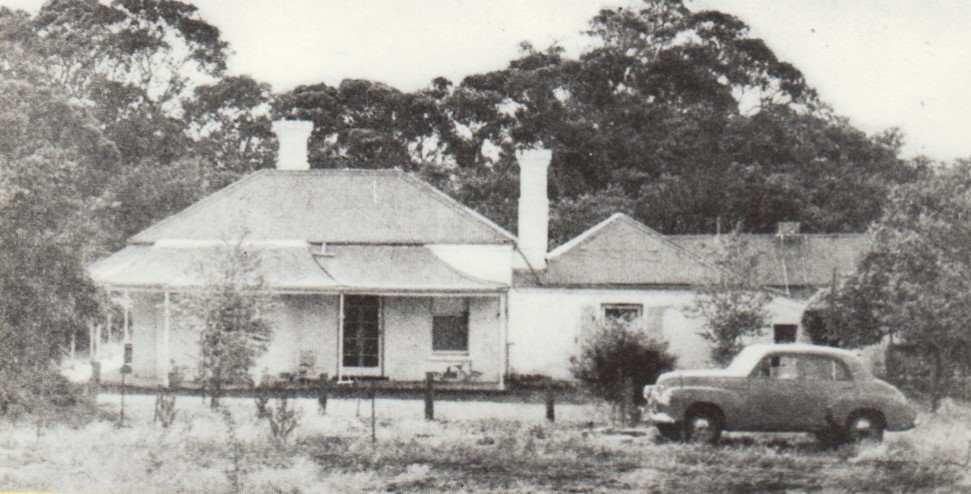
Orange Grove.
Built for Charles William Stuart, about 1838 - Demolished in 1967.
Photo from Campbelltown Local History Archive.
‘Orange Grove’ was built for Charles William Stuart (Inspector of Police) in about 1838, originally it was a sheep run called ‘No.1 Station’. However, the ghostly tale attached to this property relates to a subsequent owner and it comes to us courtesy of the 1968 history of Campbelltown, compiled by John Leaney:
“It is recorded that in about the year 1854 Francis Grote came into the Stradbroke lands [Section 346] and occupied the house built by [Charles] Stuart. He was a brother of George Grote, of Grote Street, Adelaide, and also managed land held by him. He was one of the original trustees of St. George’s Church of England, Woodforde [now Magill].
In the days of the [Adelaide] Hunt his land was used extensively and many picturesque and important [fox] hunting events were held there. This property was occupied by Grote till his death in 1867 under tragic circumstances and there was a story of a ghost huntsman which haunted this house.”
Francis Grote, who suffered from a chronic and painful illness, committed suicide by an overdose of laudanum on Monday 23 December 1867. At this time, suicide was considered a crime equal to murder, called felo de se (Latin for “felon of himself”). The jury at the inquest of Francis Grote returned a guilty verdict, which mean that Francis Grote’s property was seized by the Government, and he was buried in private between the hours of 9 and 12 o’clock at night, without the benefit of religious rites.
A century or so earlier, the same ‘crime’ may have resulted in burial at a crossroads with a stake driven through the heart. The last known crossroads burial occurred in England in June 1823. In South Australia, the verdict of felo de se was abolished under section 32(1) of the Coroner's Act 1935-1969.
Strange Happenings at Marybank
‘Marybank Estate’, now known as ‘Marybank Farm’, Montacute Road, Rostrevor, is another early property, built for Thomas Shepherd in about 1842. It too has seen its share of heartache and tragedy. The following account comes to us from personal reminiscences written by of members of the Fox family, whose descendants still own the property today.
“In a homestead so weighted with heritage, and in which so many generations have lived out their dreams and hardships, it is probably not surprising that some of those who once walked the passages still linger to watch over their home and family.
Whilst the ghosts at Marybank have never caused anyone harm, they have, on occasion caused the odd scare. Whilst visiting Dora and Gerard [Fox], one visitor received a rather threatening visitor to his room one night. The visitor was a ghostly man who wore a powdered wig. More recently, in fact, since Dora [Fox’s] death [in 1995], the figure of a woman in a long black dress has been seen gliding down the hall towards the sitting room by a dinner guest.
Strangely, the ghosts have never been seen by a family member, however, occasionally door knobs are turned by an unseen hand in the night and the laughter of children playing hide and seek is heard. A sense of the presence of the many that have gone before is almost tangible.”
One sad tale, is that of Arthur Fox, the first of the Fox family to own ‘Marybank’, who died only three months after he purchased the property in 1853. He accidently drowned in a shallow hole dug for sand, near a crossing over the River Torrens, on a dark and stormy night. He died without a will, leaving his wife and four young children with years of legal battles to retain the land.
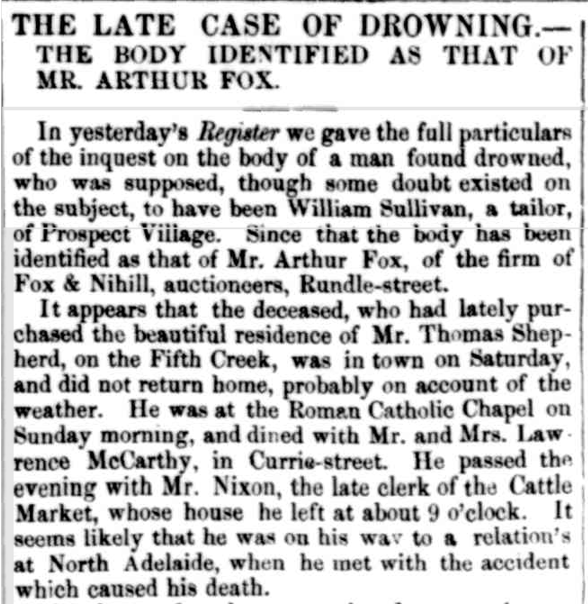
South Australian Register (Adelaide, SA), Wednesday 4 May 1853, page 3
A Hectorville Haunting
Built as ‘Fourth Creek House’ in about 1849, for the Welsh pastoralist Price Maurice, the house was re-named ‘Cosford’ in 1864 by its second owners the Hawkins family, after their family ‘seat’ in Surrey, England. The house is located in Binnswood Street, Hectorville, immediately adjacent to Fourth Creek. This account of its haunted history comes to us from the “East Torrens Messenger” newspaper in April 2011.
“Whoever snaps up Hectorville’s oldest house will have to share it with friendly ghosts.
Unusual noises are commonplace at the 160-year-old Cosford mansion on Binnswood Street, but owner James Moran says they are nothing to worry about. ‘You can hear footsteps upstairs… people walking around,’ Mr Moran said. ‘But it never worried me. As far as I was concerned they were friendly.’
Mr Moran said the house, which was for sale for an expected price of more than $1.4 million, often smelt of snuffed out candles. One night a cupboard bolted to a wall crashed to the ground. ‘There is no way it could have fallen off by itself, it had help,’ he said.
Mr Moran, who has lived at Cosford for more than 40 years, is unsure who haunts the mansion’s 12 rooms, as many people have lived there since Price Maurice built it in 1849 next to Fourth Creek on his 89 hectare farm.”
One of the many tragic stories associated with ‘Cosford’ is the death of Mrs Anna Hawkins in 1864, who was thrown from a restive horse and suffered horrific injuries beyond the medical treatment available at the time. The Hawkins family had only just arrived on the ship ‘Orient’ in August 1864 and purchased ‘Fourth Creek House’ in mid-September 1864, when the fatal accident happened the following month.
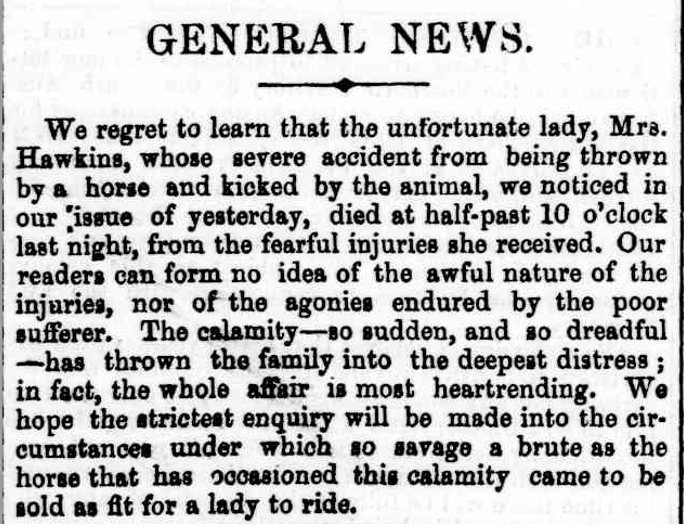
Adelaide Express (SA), Thursday 27 October 1864, page 2
Her husband died less than two years later, of natural causes, in July 1866, leaving a young family of four daughters and two sons.
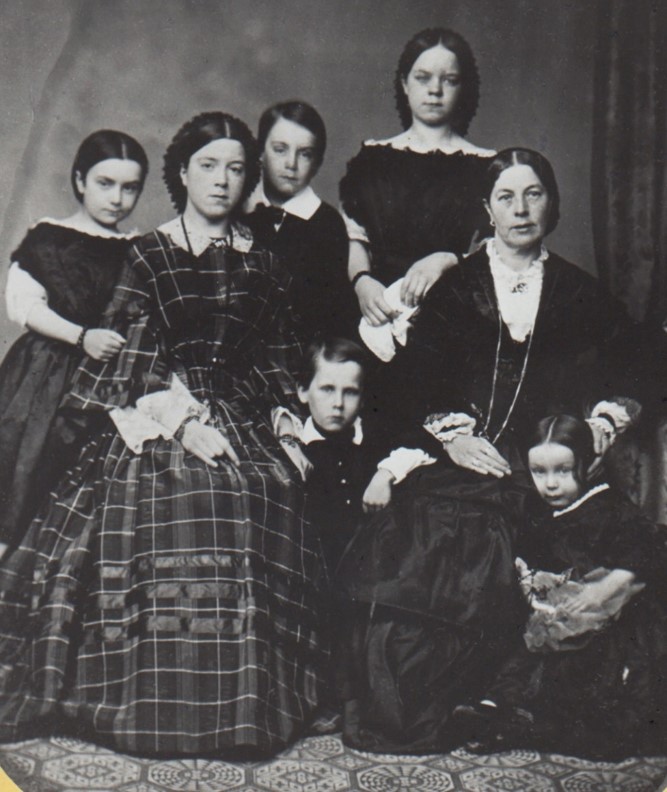
Mrs. Anna Hawkins (seated right) and her children in 1864.
Photo from Campbelltown Local History Archive.
The next occupant, Alfred Ward, leased ‘Cosford’ in December 1866, his wife Rosa died later that same month, followed a by their 15 year old daughter in February 1867.
The Ghosts of Murray Park
‘Murray Park’, now known as ‘Murray House’, is located on the Magill Campus of UniSA, St Bernards Road, Magill. The original house was built in 1843 by David Cowan, but it was completely demolished to make way for the much grander ‘Murray Park’, built in 1881 for Alexander Borthwick Murray, which was substantially extended in 1910 by his son Sir George Murray, Chief Justice of South Australia.
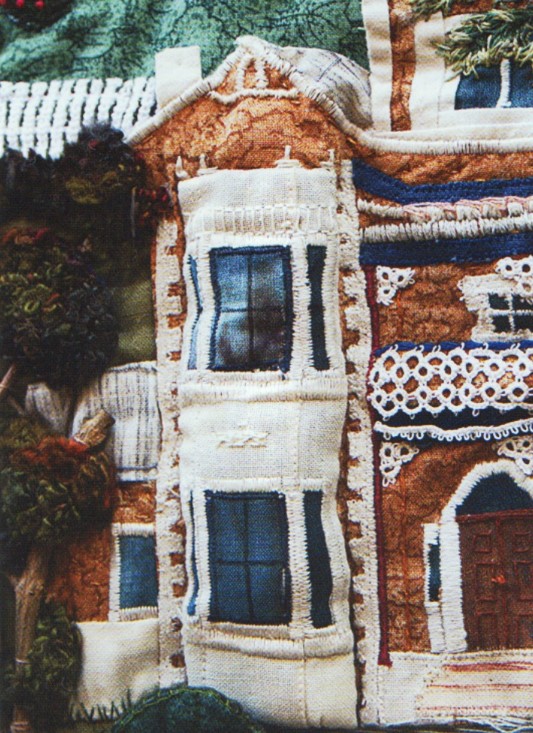
Murray Park House, showing the shadowy figure of a ghost in the first floor bay window on the Links Wall Hanging.
The ghostly tales of ‘Murray Park’ come to us from the booklet which accompanies the Campbelltown Links Wall Hanging, which is situated in the foyer of the Campbelltown Public Library. The stories relate to the first floor bay window in the oldest surviving section of the house to the rear of the property.
“Not many people are aware that Murray Park has a ghost.
A young woman in Victorian dress walks along the balcony on the first floor. Also a photo was taken at the bottom of the balustrade and when developed a 7-9 year old girl (believed to be a maid’s daughter) was standing there.
The apparition appears in the first floor bay window.”
In a nod to the persistent ghost stories, the Campbelltown Links Wall depicts the shadowy figure of a ghost in the first floor bay window of ‘Murray Park’.
YouTube video “The Haunting of Murray House” by John Oestmann
Nov 17, 2014, running time (18:27)
https://www.youtube.com/watch?v=5FJQjkg-Rtl
References:
“Campbelltown 1868 – 1968” by John T. Leaney, published by City of Campbelltown (S. Aust.) in 1968, pages 66-67.
“South Australian Weekly Chronicle”, 28 December 1867, page 6.
The Fox Family of Marybank Farm (LH BI 65), Local History Room, Campbelltown Public Library (S.Aust.).
South Australian Register (Adelaide, SA), Wednesday 4 May 1853, page 3
East Torrens Messenger, April 2011
Adelaide Express (SA), Thursday 27 October 1864, page 2
“Links: linking the past with the present.” published by Campbelltown City Council (S. Aust.) in 2009, page 43.
The Mail (Adelaide, SA), Saturday 28 July 1928, page 13. “Stately homes of Adelaide: no. 10 – Murray Park.”
“From the river to the hills: Campbelltown 150 years” by Elizabeth Warburton, City of Campbelltown (S. Aust.), 1986.
